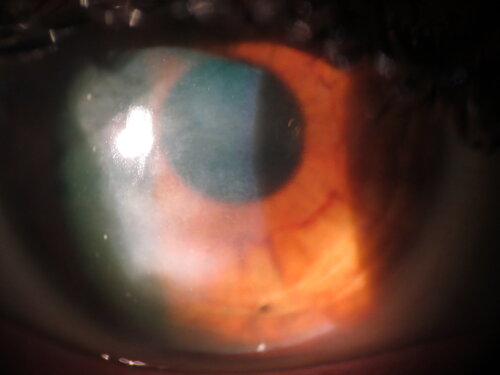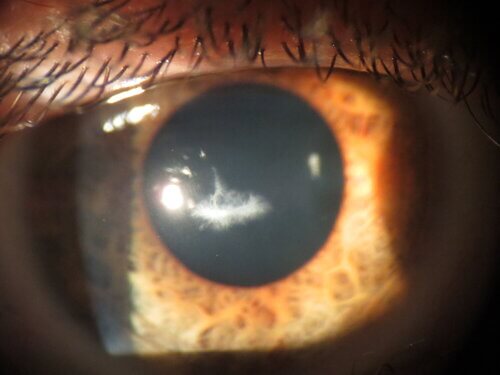What is the cornea?
The cornea is the domed shaped front surface of the eye that bends light to fall onto the retina in order for us to see clearly. It is a clear tissue that acts as a smooth interface to light as well as a barrier to irritating debris. A loss of the clarity of the tissue would interfere with our ability to see clearly. Scar tissue in the eye can distort your vision or block views of your visual field. A scar in the central part of the cornea would result in severe vision impairments. The scar tissue can also pull on the cornea, thereby interrupting its smooth surface and the way it allows light in the eye.
Corneal Scarring
The cornea is resistant to damage and typically heals from minor damage within a few days. However, deeper and more serious damage to this surface can result in scarring. Scarring of the cornea can occur through various routes, a noncomprehensive list including corneal ulcers, ocular trauma, herpes, improper contact lens useand other diseases such as syphilis.
What are the symptoms of a scarred cornea?
The cornea has many nerve endings concentrated in one area, so any damage to this surface may result in severe pain. Once the scar has formed it's usually not painful. Some other symptoms include:
- Blurred vision
- Foreign body sensation due to surface irregularities
- Light sensitivity
- Red eyes
- Eyelid or eye swelling
- Excessive tearing
- Burning or scratching sensation


How do you diagnose corneal scars?
Diagnostic testing is completed by your eye doctor during your eye exam. During the exam, your eye doctor will examine the front surface of your eye using magnifying tools such as the slit lamp and the ophthalmoscope. These tools will allow your doctor to get a better view of your eye and is a painless procedure. Your eye doctor may also utilize special dyes to better look at the layers of the cornea and assess its current state. This dye is called fluorescein and may temporarily make your tears yellow. This dye coupled with the use of a blue light allows for optimum viewing of the cornea and any eye scars. Your eye doctor will be able to determine the extent of scarring on the eye that has occurred and figure out the next steps to ensure your clarity of vision.
What conditions can cause scarring on your eye?
Corneal scarring can occur due to trauma, improper contact lens use, eye disease or degenerations, or even systemic diseases. Below is a brief overview of different conditions to look out for that can lead to corneal scarring:
Improper contact lens wear
The misuse of contact lenses is highly associated with scarring of the eye. This includes improper cleaning practices and ignoring proper replacement schedules, inadequate hand hygiene, and sleeping in contact lenses. All these factors result in an increased risk of infection that can form corneal ulcers and subsequent formation of scar tissue in the eye. Speak to your eye doctor to ensure you are following proper lens hygiene guidelines to prevent any complications.
Keratitis
Keratitis is a medical term that describes the inflammation of the cornea secondary to a viral, bacterial, or fungal infection. This can occur after an eye injury or improper contact lens hygiene. Treatment for keratitis involves antibiotics, antiviral eyedrops, antifungal eyedrops or steroid drops. Untreated keratitis may progress to permanent corneal damage such as scarring.
Ocular Herpes
Herpes is a virus that can live dormant in your body and be reactivated at later points in your life in response to stressors. Herpes Simplex Virus 1 is related to cold sores and is very common. Herpes Simplex 2 is related to genital herpes. Both conditions can result in sores on the cornea which over time can turn into permanent damage and herpes scarring. Herpes Zoster is otherwise known as shingles. If you’ve had chickenpox at some point in your life, you are at risk of shingles later on in your life. Shingles can also result in sores forming on the cornea.
Corneal Degenerations
Corneal degenerations involve problems with the structure of the cornea over time. An example of this may include keratoconus. This condition results in thinned irregular shaped corneas. The resulting shape resembles that of a cone. This irregularity in shape causes blurry vision that begins during teenage years and progresses through adulthood. Keratoconus can cause swelling and scarring to the cornea due to changes happening in the structure.
Corneal Dystrophies
Corneal dystrophies result from abnormal growths in the cornea. An example of this includes epithelial basement membrane dystrophy or EBMD. This condition involves abnormal growth on the outer layer of your eye called the epithelium. This creates scar tissue that can distort your vision and lead to a cloudy cornea. Yearly eye exams can help catch dystrophies early in order to address them in a timely manner.
Does eye scarring progress over time?
Scars on the eyeball can worsen over months or even years if there is an associated underlying eye disease such as in conditions like keratoconus. However, in cases such as injury or infection, a corneal scar may not change after the injury or infection has healed up. See your eye doctor to determine the cause of scarring in order to best treat the condition and prevent it from worsening.
Can you prevent corneal scarring?
If you are a contact lens wearer, follow strict hygiene guidelines to maintain optimal eye health, and don't sleep with your contact lenses in. This will effectively reduce your chances of corneal infection and scar tissue formation. And protect your eyes during sporting activities with the use of goggles or glasses.
Unfortunately, some conditions such as keratoconus or herpes cannot be prevented. However, with regular eye exams, one can find and treat conditions early. This will greatly improve your quality of life and reduce severe complications.
Some tips for the prevention of injury and corneal scarring include:
- Wash hands before touching the eye or area surrounding the eye. This includes washing your hands prior to inserting contact lenses.
- Use proper contact lens cleaning solutions based on the type of lens you have.
- Change out contact lens case every 2-3 months.
- Don’t sleep with contacts in.
- Know how long your contacts can be worn per day and remain within schedule
- Keep immediate eye area clean and free of makeup.
- Replace makeup applicators regularly and keep them clean
- Protect your eyes with eye goggles during sports-related activities
- Wear sunglasses outside during windy or dry weather
- Schedule regular eye exams to maintain overall health of the eye

Treatment for corneal scarring
There are multiple corneal scarring treatments available. For a mild scar in the periphery, the simple addition of glasses can improve vision. If glasses are not sufficient, special contact lenses can be customized for you to provide the best vision possible. Gas permeable contact lenses and scleral contact lenses can be useful in improving vision because of their rigid sturdy material. This would help create a smoother and more even surface of the cornea to improve vision. Laser treatments are available to remove the scar if it's shallow. This procedure is called phototherapeutic keratectomy. Corneal transplant surgery is available for very deep scars and vision that cannot be improved with contact lenses. During transplant surgery, either the whole cornea or portions of the cornea will be removed and replaced with donor human cornea. The type of surgery will depend on the location of the scar tissue on the eye as well as the nature of the scar.
Contact lenses for an irregular cornea
When a cornea is scarred, it leaves behind a mishappen and uniform surface. Eyeglasses may no longer be able to provide crisp clear vision. Soft contact lenses may be used initially for mild cases. However, more advanced scarring may require the use of more advanced specialty lenses in order to provide the best vision. This is because an irregular corneal surface makes it harder for soft contact lenses to fit well and rest comfortably on the cornea. Scleral lenses offer a great alternative to soft contacts in these cases due to their extra-large diameter. Scleral lenses vault over the cornea and rest lightly on the sclera (white part of the eye). This means that the lens is less likely to move around and will provide optimum vision correction. In addition, the sclera is not as sensitive as the cornea and may provide more comfort to the patient. Scleral lenses are associated with a lower risk of complications in the cornea as well, preventing further damage from occurring. They are custom made for your eye based off measurements collected by your eye doctor. This means that they are specially made to fit every curve of your eye. In contrast, soft contact lenses mold to whatever corneal surface that it is placed on and as a result may create distorted optics that would fail to provide crisp vision.
Some of the patients with corneal scars that we have helped





